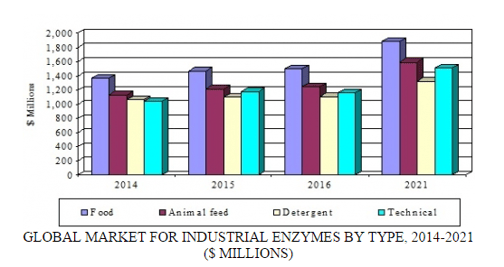
Feb 7, 2017
Blog Life Sciences Green Chemistry Boosts Global Market Growth for Industrial Enzymes
“Enzyme engineering has led to development of more efficient enzymes with new or desirable functions,” says BCC Research analyst Shalini S. Dewan. “For example, protein engineering has revolutionized the development of commercially available enzymes into better industrial catalysts. Various protein-engineering methods are used in the industry to produce desired results. These include site-directed mutagenesis, modification of proteases into peptide ligases, and production of artificial synthetic enzymes.”
Natural enzymes contain a limited number and type of reactive metal sites, which limits the potential of these enzymes to be used by industry. Enzymes that contain metal ions (that is, metalloenzymes) possess the reactivity of a transition metal center and the molecular evolution potential of enzymes. Previously, through molecular engineering, scientists expanded the scope of reactions catalyzed by naturally occurring metalloenzymes to include reactions not performed in nature. However, this strategy is limited by the reactivity of the metal centers in the native metalloenzymes.
To overcome this limitation, scientists at Lawrence Berkeley National Laboratory and the University of California, Berkeley replaced the native iron of a metalloenzyme with the precious metal iridium, which behaves differently than iron. The result is artificial enzymes for abiological catalysis within the natural binding site of an enzyme that is suitable for evolution in the laboratory. The artificial enzymes provide reactivity for specific molecules with a high degree of selectivity and catalyze reactions not catalyzed by natural iron-enzymes or other metalloenzymes.
By creating synthetic enzymes, the team has opened a new frontier for the design of catalysts that merge the strengths of biological catalysts and chemical catalysts. Merging these strengths enables diverse chemistry that cannot be carried out by classic biological or chemical complexes alone. This research could reduce the cost, time, or waste produced in industrial reactions for biofuels, fossil fuels, and more. As a part of follow-up research, this team has managed to improve the bionic enzymes to match rates found in natural enzymes. (MilTech; January 27, 2017)
A new analysis by BCC Research shows that the enzyme industry is a very lucrative market. The goal of players in the enzyme market is to design enhanced products and processes that not only are competitive, but that also meet the essential requirements of sustainability. Enzyme-based processes are gradually replacing chemical processes in many areas of industry. Enzymes provide advantages such as higher product quality, lower manufacturing cost, less waste, and reduced energy consumption. Key market drivers include new enzyme technologies, surging demand from the food industry and from producers of animal feed, and increased need for more renewable sources of energy such as cellulosic bioethanol.
According to BCC Research, the global market for industrial enzymes is expected to grow from nearly $5.0 billion in 2016 to $6.3 billion in 2021, demonstrating a five-year compound annual growth rate (CAGR) of 4.7%. As a segment, food industrial enzymes should approach $1.5 billion and $1.9 billion in 2016 and 2021, respectively, growing at a five-year CAGR of 4.7%. Animal feed industrial enzymes, as a segment, is forecast to total $1.2 billion and nearly $1.6 billion in 2016 and 2021, respectively, reflecting a five-year CAGR of 5.2%. This market segment is expected to rise due to higher investments in renewable sources of energy and increased demand for animal feed products.
GLOBAL MARKET FOR INDUSTRIAL ENZYMES BY TYPE, 2014-2021

Population growth and a global need for cleaner and greener alternatives are also market drivers, further augmenting the demand for enzymes. Globalization and the increase in research and development within the enzyme market are also forces that are driving growth. Enzymes have revolutionized the research approach for various conditions. Enzymes have paved the way for a new class of drugs that allow for highly specific treatment, prevention, and control of many injuries and diseases. In addition, biotechnological advances have led to the replacement of harsh chemicals with biodegradable enzymes in various industrial processes.
BCC Research’s study, Global Markets for Enzymes in Industrial Applications, analyzes industrial enzyme applications, with emphasis on technical enzymes and those used in the food and beverage industry. The report also discusses merger, acquisition, and collaboration strategies, as well as the competitive landscape and structure of the industry. Global market drivers and trends, with data from 2015, estimates for 2016, and projections of CAGRs through 2021, are provided.
In today’s fast-paced biomedical world, researchers and pharmaceutical companies...

Radiopharmaceuticals represent a cutting-edge frontier in modern medicine, offer...

Implantable Remote Patient Monitoring (IRPM) devices are revolutionizing healthc...

We are your trusted research partner, providing actionable insights and custom consulting across life sciences, advanced materials, and technology. Allow BCC Research to nurture your smartest business decisions today, tomorrow, and beyond.
Contact UsBCC Research provides objective, unbiased measurement and assessment of market opportunities with detailed market research reports. Our experienced industry analysts assess growth opportunities, market sizing, technologies, applications, supply chains and companies with the singular goal of helping you make informed business decisions, free of noise and hype.